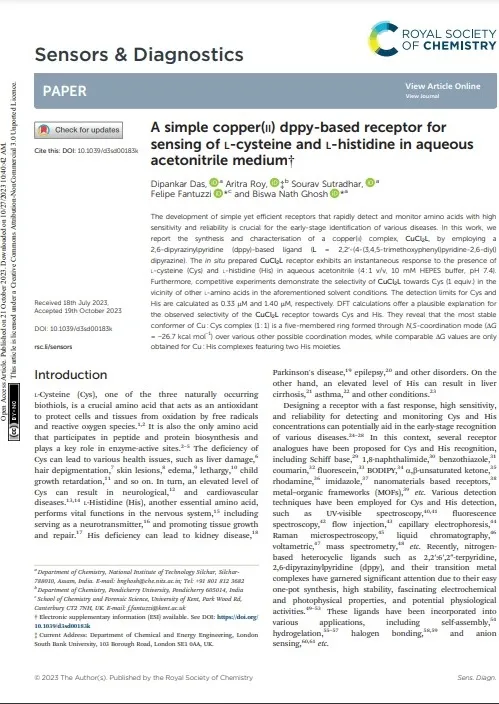Authors
Dipankar Das, Aritra Roy, Sourav Sutradhar, Felipe Fantuzzi and Biswa Nath Ghosh
DOI
10.1039/D3SD00183K
Abstract
The development of simple yet efficient receptors that rapidly detect and monitor amino acids with high sensitivity and reliability is crucial for the early-stage identification of various diseases. In this work, we report the synthesis and characterisation of a copper(II) complex, CuCl2L, by employing a 2,6-dipyrazinylpyridine (dppy)-based ligand (L = 2,2’-(4-(3,4,5-trimethoxyphenyl)pyridine-2,6-diyl)dipyrazine). The in-situ prepared CuCl2L receptor exhibits an instantaneous response to the presence of L-Cysteine (Cys) and L-Histidine (His) in aqueous acetonitrile (4:1 v/v, 10 mM HEPES buffer, pH 7.4). Furthermore, competitive experiments demonstrate the selectivity of CuCl2L towards Cys (1 equiv.) in the vicinity of other L-amino acids in the aforementioned solvent conditions. The lowest detection limits for Cys and His are calculated as 0.33 µM and 1.40 µM, respectively. DFT calculations offer a plausible explanation for the observed selectivity of the CuCl2L receptor towards Cys and His. They reveal that the most stable conformer of Cu:Cys complex (1:1) is a five-membered ring formed through N,S-coordination mode (ΔG = –26.7 kcal mol–1) over various other possible coordination modes, while comparable ΔG values are only obtained for Cu:His complexes featuring two His moieties.
